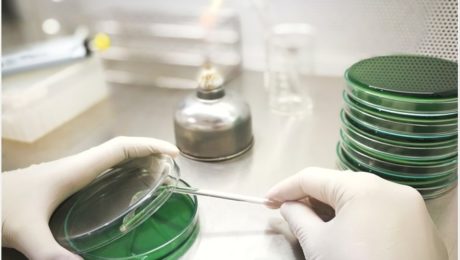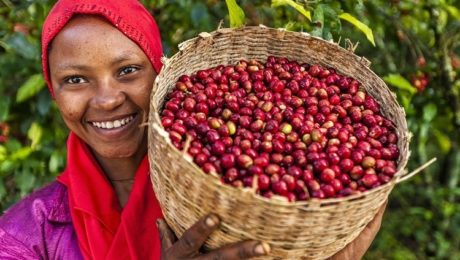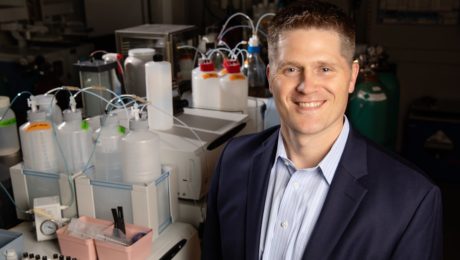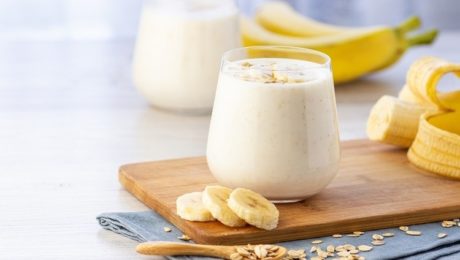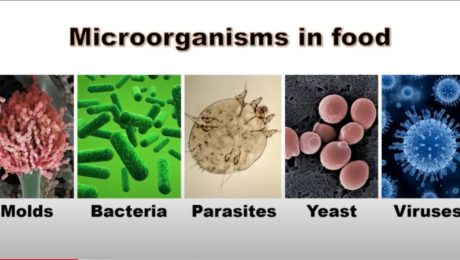Supplements vs. Fermented Foods
Two UCLA professors of medicine encourage people “rather than thinking in terms of supplements, add some fermented foods to your diet.” In a Q&A, the doctors say the popularity of probiotics, postbiotics and the gut microbiome has blurred their value, despite the plethora of reputable scientific research. Product manufacturers — as has happened before, with terms like “gluten-free” — have begun labelling everything as containing -biotics or benefitting the gut microbiome.
“The word probiotics refers to the beneficial microbes found in certain fermented foods and beverages, as well [as] in specially formulated nutritional supplements,” write UCLA doctors Eve Glazier and Elizabeth Ko. “That means that any fermented food that contains or was made by live bacteria contains postbiotics. … Initial findings suggest that postbiotics may play a role in maintaining a balanced and robust immune system, support digestive health and help to manage the health of the gut microbiome.”
Read more (Journal Review)
- Published in Science
Kefir Brands Respond
The kefir brands recently tested for their probiotic claims are challenging the results.
In May, a study found 66% of commercial kefir products overstated probiotic counts and “contained species not included on the label.” The Journal of Dairy Science Communications published the peer-reviewed work by researchers at the University of Illinois and Ohio State University.
“Based on the results…there should be more regulatory oversight on label accuracy for commercial kefir products to reduce the number of claims that can be misleading to consumers,” reads the study. “Classification as a ‘cultured milk product’ by the FDA requires disclosure of added microorganisms, yet regulation of ingredient quality and viability need to be better scrutinized. All 5 kefir products guaranteed specific bacterial species used in fermentation, yet no product matched its labeling completely.”
Researchers tested two bottles of each of five major kefir brands: Maple Hill Plain Kefir, Siggi’s Plain Filmjölk, Redwood Hill Farm Plain Goat Milk Kefir, CoYo Kefir and Lifeway Original Kefir. Bottles were measured for microbial count and taxonomy to validate label claims.
The Fermentation Association reached out to the five brands involved and asked for their responses to the results. Redwood Hill and Lifeway both submitted detailed statements. Maple Hill, Siggi’s and CoYo did not return multiple requests for comment.
Probiotic Count
Probiotics in fermented products are listed in colony-forming units (CFUs), and the study found kefir from both Lifeway and Redwood Hill contained fewer CFUs than what was claimed on the label. But these brands — who send their products to third-party labs for testing — said the results are not accurate.
Lifeway refutes the assertion that their Original Kefir did not meet the claimed probiotic count. Lifeway references U.S. Food and Drug Administration food labeling laws, which dictate that a product “must provide all nutrient and food component quantities in relation to a serving size.” Lifeway’s label on their 32-ounce bottle says that the serving size of kefir is 1 cup, making the claim of 25-30 billion CFUs per serving size accurate.
The study results, Lifeway notes in their statement, were “premised upon an erroneous assumption that Lifeway claims it has 25-30 billion CFUs per gram” rather than per serving size.
“The authors’ flawed assumption is perhaps a result of their lack of familiarity with FDA labeling requirements or a result of merely overlooking the details in order to support their intended conclusions going into the testing,” reads a statement from Lifeway.
In fact, Lifeway points out, the study’s “erroneous conclusion premised upon the flawed assumption…actually proves the accuracy of Lifeway’s claim of 25-30 billion CFUs per (8 ounce) serving.”
Redwood Hill Farm, too, refutes the study’s conclusion. Their Goat Milk Kefir currently includes the phrase “millions of probiotics per sip” on its label. The label referenced in the study was an old version that claimed “hundreds of billions” of probiotics, which was discontinued last year. According to Redwood Hill Farm, that old label was based on third-party testing that confirmed hundreds of billions of CFUs per 8-ounce serving. But careful review of the kefir’s probiotic counts in 2019-2020 found some CFUs in the hundreds of billions and others in the tens of billions. Redwood Hill changed their label to millions rather than billions “to be absolutely sure that we could meet our target claim on a consistent basis.”
Variation in CFU counts is common in traditional plating testing techniques. Redwood Hill referenced a study published in Nutritional Outlook that found that plating results can vary 30-50%.
“Given the challenges around probiotic CFU enumeration, we were not too surprised to see a discrepancy between the number of CFUs in our Goat Milk Kefir found in the study and our past analyses,” reads the statement from Redwood Hill Farm. “Like all living organisms, probiotics are challenging to control and measure. A particular microorganism’s ability to reproduce is impacted by a variety of factors, including temperature, oxygen level, variations in the nutrient composition of the milk, and pH level. Our kefir has a sixty-day shelf life and during that time the different types of bacteria in the product will peak and die-off in relation to the conditions those particular bacteria like. For example, fermented dairy products naturally become more acidic (lower pH) as they age and while some bacteria thrive in acidic environments, others’ reproduction is stunted. This makes the exact CFU count rather volatile not only from bottle to bottle, but also throughout the timespan between when that bottle leaves our facility and when it expires.”
Redwood Hill Farm’s most recent testing measured 400 million CFUs per gram or 96 billion per serving (1 cup). These figures compare with what the study found — 193 million CFUs per gram or 46 billion per serving.
“Although the University of Illinois study found only half the probiotic cells that our study did, this is actually not that wide of a variation in bacteria reproduction based on all of the conditional factors outlined above,” their statement reads.
Species Count
The study’s test results found all kefir brands contained species not on the label. Lifeway notes their culture claims are based on the time of manufacture, not on expiration date. “Moreover, the authors validate that all of the claimed culture species except for the bifidos, Leuconostoc and L. reuteri, (which could be at a low concentration due to time of shelf-life), were identified in their testing,” reads Lifeway’s statement.
Redwood Hill Farm says that, based on the study results (that “2 Lactobacillus delbrueckii subspecies or 3 Lc. lactis subspecies could not be identified” in their kefir), they are pursuing further analysis. They’ve contacted their culture supplier for further insight, and are sending new samples to a third-party lab.
“These cultures are at the heart of the product and are what transforms the goat milk into a yogurt drink with its characteristic thick and creamy texture and tart flavor,” reads the Redwood Hill Farm statement. “It’s difficult to understand how these core active agents in the kefir could not be present in the product at any stage in its lifecycle.”
DNA vs. Plating Methodology
The study utilized both DNA sequencing and traditional plating methodologies, even though plating testing alone is considered the industry standard for kefir. Plating testing for kefir is done in a microbiology laboratory where it’s incubated to determine bacteria colony growth.
The study itself notes: “Limitation of DNA-based sequencing methods could explain why taxa stated on labels were not detected and why unclaimed viable species were identified.”
Lifeway points out: “This concession as to testing limitations is critical to note as it is but one explanation of many as to why various species may have not been detected. First and foremost, the authors fail to validate the DNA extraction method to establish that it delivers all the available DNA in the type of dairy product analyzed; for example, they do not appear to have broken down the calcium bonds. Further, they appear to not have undertaken the required extra enzymatic treatments. Moreover, for their microanalysis, they are using MRS [a method for cultivation of lactobacilli] but only incubating for 48 hours. As most kefir products would contain a significant amount of Lactococci, there is a high chance of not detecting this species unless you go to 72 hours of incubation. Another unknown important factor in the testing is the time period within the cycle of the shelf-life of the product that was tested. This is critical as the longer the product sits on a shelf, the fewer number of live and active bacteria will be present.”
Meanwhile, Redwood Hill Farm says “our team will continue to educate ourselves on the application of DNA sequencing technology to fermented food product probiotic count analysis and what opportunities and limitations this methodology may offer versus traditional plating techniques.”
- Published in Science
Advances in Yeast
We’re in the midst of a yeast revolution, as genome sequencing creates opportunity for cutting-edge advances in fermented foods and drinks. Yeast will be at the forefront of innovation in fermentation, for new flavors, better quality and more sustainability.
“Understanding and respecting tradition is a key part of this. These practices have been tested for hundreds and thousands of years and they cannot be dismissed. There’s a lot the science can learn from tradition,” says Richard Preiss of Escarpment Laboratories. Priess was joined by Ben Wolfe, PhD, associate professor at Tufts University (and TFA Advisory Board member), during a TFA webinar, Advances in Yeast.
Preiss continues: “There’s still a place for innovation, despite such a long history of tradition with fermentation. A lot of the key advances in science are literally a result of people trying to make fermentation better.”
Wolfe, who uses fermented foods and other microbial communities to study microbiomes in his lab at Tufts, said “there’s this tradition versus technology conflict that can emerge.”
“I tell my students when I teach microbiology that much of the history of microbiology is food microbiology, it is actually food microbes, and they really drove the innovation of the field so it really all comes back to food and fermentation,” Wolfe says.
The technology relating to the yeasts used in fermentation has expanded enormously over the last decade, due heavily to advances in genome sequencing. Studying genetics allows labs like the ones Priess and Wolfe run to find the genetic blueprint of an organism and apply it to yeast. Drilling down further, they can tie genotype to phenotype to determine characteristics of a yeast strain. This rapidly expanding technology will disrupt and advance fermentation.
Priess predicted three areas of development for yeast fermentation in the coming years:
- Novelty Strains
Consumers have accelerated their acceptance of e-commerce during the Covid-19 pandemic and they’ll do the same for biotechnology, Priess says.
“Our industry does thrive on novelty,” he adds, noting there are beer brands already creating drinks with GMO yeast. “Craft beer is going to be the first food space where the use of GMOs is widespread — we’re seeing that play out a lot faster than I ever thought it would be with some of these products already on the market. Novelty does have value.”
Wolfe noted many consumers shudder at the idea of a GMO food or beverage, but microbes in beer are dead. Consumers are not drinking a living GMO in beer.
Yeasts also already pick up new genetic material naturally, through a process called gene transfer.
“It’s part of the evolutionary process that all microbes go through,” Wolfe says. “From my own lab and from other labs, cheese and sauerkraut and all these other fermented foods are showing so much genetic exchange that’s already happening.”
- Climate Change
The food industry must address growing concerns about climate change. Priess predicts breeding plants — like barley, hops and grapes — that are more drought-tolerant, or even using yeast technologies to increase yields or the rate of fermentation.
“Craft beer is massively wasteful,” Priess says. It takes between three to seven barrels of water to make one barrel of beer. “It is something we’re going to have to reckon with the next 10 years.”
Yogurt and cheese, too, produce large amounts of waste products.
- Ease of Genomics
The cost and time of genome sequencing has reduced significantly. It used to cost thousands of dollars and take many weeks to document a yeast genome. Now, it can be done for $200 in only a few days.
“The tools to deal with the data and get some meaning from it have never been more accessible. It’s incredibly powerful,” Priess says. “We’re developing solutions for products without millions of dollars.”
Priess does not agree with companies patenting yeasts, “it’s murky territory.” He believes fermentation and science should be about collaboration, not ownership and protection.
“Working with brewers and other fermentation enthusiasts, it’s this incredibly open and collaborative space compared to a lot of the industries,” he says. “I think that’s like our secret weapon or our secret value is that fermentation is so open in terms of access to knowledge as well as in terms of people being willing to experiment and try new things. That’s how it’s able to develop so quickly.”
- Published in Food & Flavor, Science
Study: Can Fermented Veggies Impact Health?
Is there a connection between a happy gut and a healthy heart? The University of North Florida Department of Nutrition and Dietetics is conducting a study to determine what impact a diet rich in fermented vegetables has on cardiovascular disease and markers of inflammation.
Participants will be placed in two groups — the first consumes their regular diet for eight weeks, then receives fermented vegetables at the end of the study. The second will eat a half cup of fermented vegetables every day for eight weeks.
“These studies are the only way nutritionists can determine if certain foods can help with prevention and/or treatment of common health problems faced by our community, such as cardiovascular disease,” says Dr. Andrea Arikawa, associate professor at the university.
Read more (University of North Florida)
Fermentation Time Shapes Coffee Flavor
Adding to the growing research on fermentation and its impact on coffee’s flavor, food corp Nestlé released their own study on the link between coffee and fermentation. Scientists found that the length of time coffee cherries (or beans) are fermented is key to final flavor. They plan to use their findings to “tailor specific fermentation conditions to different coffee varieties, allowing us to highlight new distinct natural flavors and sensorial notes.”
“While several favors affect coffee quality, we showed a subtle combination of specific fermentation conditions can lead to a modulation of the sensory properties of the final cup, opening new avenues to differentiate coffee taste in a fully natural way,” said Cyril Moccand, a scientist at Nestlé Research who led the study.
On August 11, The Fermentation Association will host a webinar with the Specialty Coffee Association “The State of the Art in Coffee Fermentation.”
Read more (Beverage Daily)
- Published in Food & Flavor, Science
What’s the Actual Probiotic Count of Commercial Kefir?
A new peer-reviewed study from researchers at the University of Illinois and Ohio State University found 66% of commercial kefir products overstated probiotic count and “contained species not included on the label.”
Kefir, widely consumed in Europe and the Middle East, is growing in popularity in the U.S. Researchers examined the bacterial content of five kefir brands. Their results, published in the Journal of Dairy Science, challenge the “probiotic punch” the labels claim.
“Our study shows better quality control of kefir products is required to demonstrate and understand their potential health benefits,” says Kelly Swanson, professor in human nutrition in the Department of Animal Sciences and the Division of Nutritional Sciences at the University of Illinois. “It is important for consumers to know the accurate contents of the fermented foods they consume.”
Probiotics in fermented products are listed in colony-forming units (CFUs). The more probiotics, the greater the health benefit.
According to a news release from the University of Illinois: “Most companies guarantee minimum counts of at least a billion bacteria per gram, with many claiming up to 10 or 100 billion. Because food-fermenting microorganisms have a long history of use, are non-pathogenic, and do not produce harmful substances, they are considered ‘Generally Recognized As Safe’ (GRAS) by the U.S. Food and Drug Administration and require no further approvals for use. That means companies are free to make claims about bacteria count with little regulation or oversight.”
To perform the study, the researchers bought two bottles of each of five major kefir brands. Bottles were brought to the lab where bacterial cells were counted and bacterial species identified. Only one of the brands studied had the amount of probiotics listed on its label.
“Just like probiotics, the health benefits of kefirs and other fermented foods will largely be dependent on the type and density of microorganisms present,” Swanson says. “With trillions of bacteria already inhabiting the gut, billions are usually necessary for health promotion. These product shortcomings in regard to bacterial counts will most certainly reduce their likelihood of providing benefits.”
The news release continues:
When the research team compared the bacteria in their samples against the ones listed on the label, there were distinct discrepancies. Some species were missing altogether, while others were present but unlisted. All five products contained, but didn’t list, Streptococcus salivarius. And four out of five contained Lactobacillus paracasei.
Both species are common starter strains in the production of yogurts and other fermented foods. Because those bacteria are relatively safe and may contribute to the health benefits of fermented foods, Swanson says it’s not clear why they aren’t listed on the labels.
Although the study only tested five products, Swanson suggests the results are emblematic of a larger issue in the fermented foods market.
“Even though fermented foods and beverages have been important components of the human food supply for thousands of years, few well-designed studies on their composition and health benefits have been conducted outside of yogurt. Our results underscore just how important it is to study these products,” he says. “And given the absence of regulatory scrutiny, consumers should be wary and demand better-quality commercial fermented foods.”
Defining Postbiotics
As postbiotics continue to trend among consumers, the International Scientific Association for Probiotics and Prebiotics (ISAPP) released a consensus definition on the category, published in Nature Reviews: Gastroenterology & Hepatology.
The panel of international experts that created the definition made it clear that postbiotics and probiotics are fundamentally different. Probiotics are live microorganisms; postbiotics are non-living microorganisms. The published definition states that postbiotics are a: “preparation of inanimate microorganisms and/or their components that confers a health benefit on the host.”
Inactive Microorganisms
A postbiotic could be whole microbial cells or components of cells, “as long as they have somehow been deliberately inactivated,” according to the news release by ISAPP. And a postbiotic does not need to be derived from a probiotic.
“With this definition of postbiotics, we wanted to acknowledge that different live microorganisms respond to different methods of inactivation,” says Seppo Salminen, professor at the University of Turku and the lead author of the definition. “Furthermore, we used the word ‘inanimate’ in favor of words such as ‘killed’ or ‘inert’ because the latter could suggest the products had no biological activity.”
The definition has been in the works for almost two years by authors from various disciplines in the probiotics and postbiotics fields. These include: gastroenterology, pediatrics, metabolomics, functional genomics, cellular physiology and immunology.
“This was a challenging definition to settle,” says Mary Ellen Sanders, ISAPP’s Executive Science Officer. “There are some who think that any purified component from microbial growth should be considered to be a postbiotic, but the panel clearly felt that purified, microbe-derived substances, for example, butyrate or any antibiotic, should just be called by their chemical names. We are confident we captured the essential elements of the postbiotic concept, allowing for many innovative products in this category in the years ahead.”
Growing Scientific Interest
Sanders continues: “The definition will be a touchstone for scientists, both in academia and industry, as they work to develop products that benefit host health in new ways. We hope this clarified definition will be embraced by all stakeholders, so that when the term ‘postbiotics’ is used on a product, consumers will know what to expect.”
Postbiotics have been on the market in Japan for years, and fermented infant formulas with added postbiotics are sold commercially in South America, the Middle East and in some European countries. ISAPP, in a release, notes: “Given the scientific groundswell, postbiotic applications are likely to expand quickly.”
The definition is the latest in a series of international consensus definitions by ISAPP. These include: probiotics, prebiotics, synbiotics and fermented foods.
- Probiotics: Live microorganisms that, when administered in adequate amounts, confer a health benefit on the host.
- Prebiotics: A substrate that is selectively utilized by host microorganisms conferring a health benefit.
- Synbiotics: A mixture comprising live microorganisms and substrate(s) selectively utilized by host microorganisms that confers a health benefit on the host.
- Fermented foods: Foods made through desired microbial growth and enzymatic conversions of food components.
- Published in Science
Dairy-Free “Vegurt”
Chr. Hansen, a global bioscience supplier of ingredients, has developed Vega Culture Kits, a new line of probiotic starter cultures that can be used to create plant-based yogurt. “Vegurt,” a shortening of vegan or vegetarian yogurt, is the name being used for this non-dairy product. This term was created in reaction to the European Parliament’s current debate over whether plant-based products can use dairy-related terms like yogurt and milk.
“Vegurt seemed a catchy and suitable category name compared to having to sprain our tongues calling them ‘fermented plant-based alternatives to dairy yogurt,’” said Dr. Ross Critenden, senior director for commercial development at Chr. Hansen.
The Vega Culture Kits are designed to “robustly ferment” any dairy-free plant base, like nuts, cereals, legumes or seeds. The Vega Culture will appear as “culture” on ingredient lists, in the same way that dairy yogurts include “culture” when cultures or probiotic strains are added.
Read more (Food Navigator)
- Published in Science
Syn-SCOBY
Engineers at MIT and the U.S. Army Research Lab have developed what they call Syn-SCOBY, a living material made from laboratory yeast and bacteria. Similar to a kombucha mother, it is a tough cellulose material that researchers say can be used to purify water and detect pollutants. They envision Syn-SCOBY being used in the biomedical field and for food applications.
“We foresee a future where diverse materials could be grown at home or in local production facilities, using biology rather than resource-intensive centralized manufacturing,” said associate professor Timothy Lu, of MIT’s departments of biological engineering and electrical engineering and computer science.
Read more (MIT)
- Published in Science
The Safety of Fermented Food
Thanks to lactic acid — which kills harmful bacteria during fermentation — fermented foods are arguably among the safest foods that humans eat. But if critical errors are made, there is the risk of food safety hazards.
“When we talk about fruit and vegetable ferments, there is a very long history of microbial safety with traditionally fermented fruits and vegetables,” says Erin DiCaprio, extension specialist at University of California, Davis, Department of Food Science and Technology. “While outbreaks associated with fermented fruits and vegetables are rare, vegetable and fruit fermentation is not without risk.”
DiCaprio, a food safety expert, detailed proper food safety protocols during a webinar for EATLAC, a UC Davis project putting scientific knowledge and research behind fermentation. DiCaprio shared two documented instances of fermented foods causing a foodborne illness, both from small-scale batches of kimchi. But she emphasized that, when all food safety concerns are mitigated, fermented foods do not pose a risk.
“From the food microbiology standpoint, bacteria really are the most important group of microorganisms because bacteria, certain types of bacteria, are a food safety concern,” she adds. “There are many different types of bacteria that contribute to food spoilage and, of course, there are specific types of bacteria that are used beneficially for fermentation.”
What happens during fermentation that makes food safe? Lactic acid bacteria are created, which convert sugars into lactic acid, acetic acid and CO2. Those antimicrobial compounds help fight off pathogens, competing with other microbes for nutrition sources.
Biological hazards — bacteria, viruses and parasites that can cause foodborne illnesses — are the biggest concerns. Botulism, E. coli and salmonella are the main hazards for fermented foods. Botulism can form in oxygen-free conditions if a fermentation is not successful and acid levels are too low. E. coli and salmonella form when sanitation practices are not followed.
“Commercially, when someone is developing a valid fermentation process, they are typically going to be looking to see that sufficient acid is produced during fermentation, to inactivate some of these acid tolerant (bacteria),” DiCaprio says. “Our traditional vegetable fermentations — things like fermented cucumber, sauerkraut, kimchi — they’ve all been shown to produce sufficient acid to inactivate the sugar toxin producing e-coli, so from a safety standpoint, sufficient acid production is the critical control point for ensuring the safety of a fermented fruit or vegetable. “
There are seven critical factors to keep a ferment safe:
- High-quality, raw ingredients. “If there are a high number of spoilage microorganisms to start with, it will be really difficult for the lactic acid bacteria to dominate the fermentation,” DiCaprio says.
- Research-based recipe. Following a tested recipe ensures the proper balance of ingredients to keep the food safe.
- Proper sanitation. Cleaning of all utensils and surfaces ensures no pathogens will contaminate the food. This mitigates cross-contamination risk, too.
- Preparation of ingredients. Food particles should be uniform in size, either cut in small slices or shredded. Smaller pieces release more water and nutrients, promoting the growth of lactic acid bacteria.
- Salt concentration. Lactic acid bacteria thrive in a salt brine. The key amount: anywhere from 1-15% salt brine by weight of the ferment.
- Appropriate temperature. A temperature between 65-75 degrees fahrenheit is ideal to keep spoilage microorganisms at bay.
- Adequate time. “It takes a while for significant acid to be produced, so be patient and follow the directions in the recipe,” DiCaprio advises. Most fruit and vegetable ferments take 3-6 weeks to be completed.


